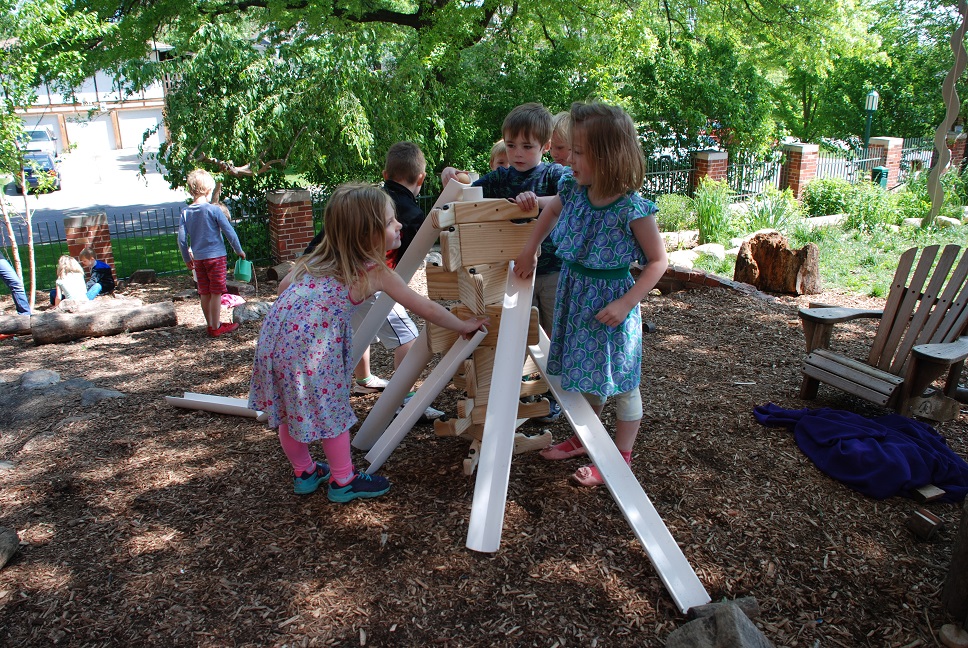Full STEAM Ahead in The Outdoor Classroom (Part 1)

STEAM (science, technology, engineering, art and math) education, a national priority, informs school curricula at all grade levels. Often, this teaching/learning moves from the abstract to the concrete (A to C). For example, children could learn a simplified definition of ‘classification’ before using materials or images in lesson exercises designed to demonstrate the concept. Understanding the basics of why something should be learned before actually performing that learning makes sense.
Yet learning based on moving from the concrete to the abstract (C to A) also makes sense. If a child is already operationalizing an abstract concept during a play activity, the wise teacher can scaffold his “play” into STEAM learning.
The well-supplied Nature Explore Classroom is an ideal environment for this C to A learning—with one hitch. The concrete activities that involve STEAM concepts happen best during self-directed free play. Activities performed during free play are intrinsically motivating to the child, so the added conceptual learning will already have firm roots. The observant adult, acting more as a consultant than a teacher, can make the abstract concept behind the play visible to the child. By definition, this new learning is valuable to the child, who is already in the process of using it.
Before looking more deeply at these possibilities, we should acknowledge some differences between traditional A to C STEAM learning and this ‘reverse’ model. Indoors, STEAM learning is usually tied to lessons in a curriculum. The learning is organized and graduated. Lessons build upon previous lessons. Often the concepts taught are part of a state or federal instructional mandate. This kind of STEAM curriculum can be just as effective when taught outdoors as when taught indoors.
The STEAM learning we’ll see in this C to A learning model is tied to the children’s ongoing, self-motivated activities. As children shift activities and focus, the adult may shift with them, ensuring that the learning stays within the child’s motivational focus. This kind of learning is often not graduated or sequential in terms of concepts made visible to the child. It is not meant to replace the systematic development of STEAM competencies.
Yet by rooting this learning in activities the child is already motivated to perform it has some very special characteristics. What happens when the adult puts into words the abstract concepts behind the child’s play? For one, the child is reinforced for having existing competencies. The adult is telling her that what she is doing because she likes doing it is important. This dynamic is far different from the A to C teaching which starts with an idea that is defined as important for the child to learn. Secondly, this learning is likely to be used again, and expanded upon during further self-directed play.
The systematic learning of STEAM concepts is not the goal of this concrete to abstract learning. Yet a different and very profound kind of learning might just be taking place. For an explanation, we return to an old friend.
David Hawkins, (the philosopher/educator we’ve met in earlier blog posts), wrote about the special qualities of concrete to abstract learning. A scientist himself, he enabled many learning experiences for children in natural environments. He reasoned that young children whose play and explorations involved science and math would internalize concepts they would later learn formally in their studies. When learned in future classrooms, these abstract concepts would resonate with the student’s earlier concrete expression of them during play. Having ‘felt’ the concepts during play as a child, the older learner would integrate the new conceptual learning more quickly and deeply.
In next week’s blog post, we’ll see some further considerations for enabling STEAM learning in the outdoor classroom. And we’ll consider some best practices for this kind of “consultation,” gleaned from expert practitioners in natural settings.

